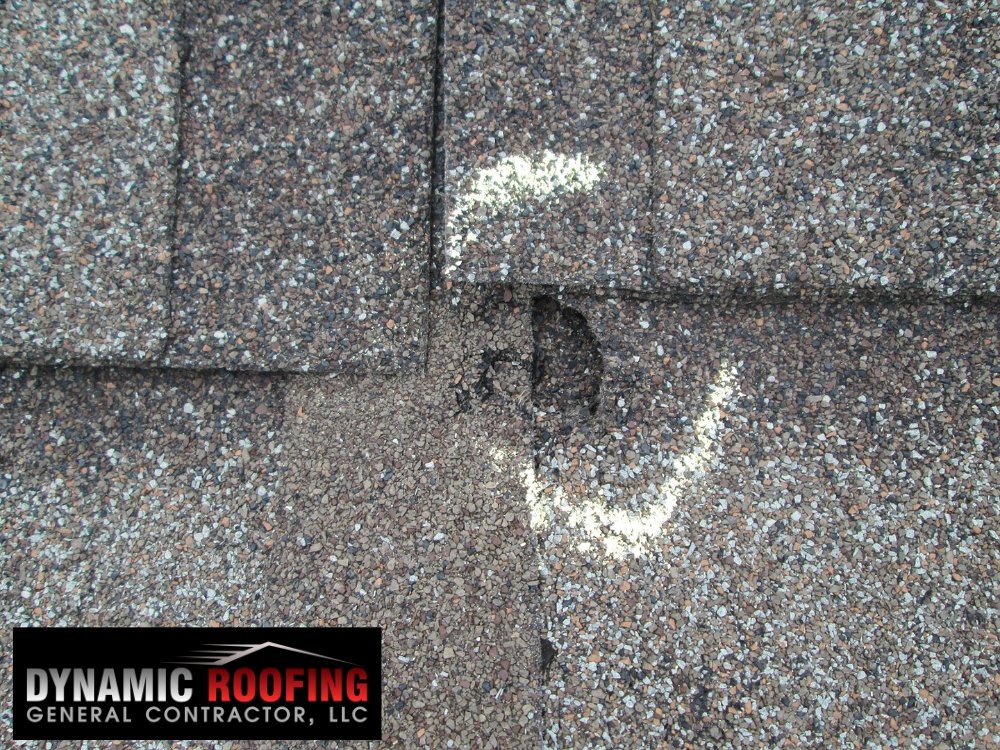Many areas around Texas are known to receive hailstorms every year, and Plano is no exception.
Therefore, when this kind of storm hits you, it is important to know what you can expect — what kind of damage it can cause to your home, how you can detect it, what you can do about it and more.
The roof of your home is especially susceptible to damage from hail and, because it’s a very important part of your home, you should always inspect it after a hailstorm passes — or call the professionals at Dynamic Roofing to inspect it for you.
Hail Damage to Plano Roofs: The Basics
 Your roof can get damaged whether it is brand new or a bit older, and it’s important that you inspect it (or at least call a Plano roofer) to do it for you.
Your roof can get damaged whether it is brand new or a bit older, and it’s important that you inspect it (or at least call a Plano roofer) to do it for you.
Here are some of the visible indicators that your roof has suffered hail damage and that require professional attention:
- Dents and cracks on your home and roofing system
- Missing shingles
- Bruising on shingles
The following sections explain.
Dents and Cracks on Your Home and Roofing System
In order to check your home and roof in Plano thoroughly for damages caused by hail, you should first wait for the hailstorm to completely die down and start your inspection only when it’s safe.
The hail inspection can begin with the most exposed parts of your home, such as the gutters, siding and downspouts, and work your way up to the roof. If there are any new dents and cracks on your house that weren’t there before hail, there’s a good chance that your roof was damaged as well.
Therefore, carefully inspect the gutter system, siding, and even your car if it was parked outside.
If the hail was strong and big, the dents and cracks will be easily noticeable. If the hail pieces were smaller, on the other hand, then you should pay closer attention and try to detect any smaller dents.
What Do Dents and Cracks Look Like?
To spot dents and cracks caused by hail on your home, you’ll need to perform a careful inspection after a hailstorm. Look closely at your roof and siding for any new pockmarks or dents that weren’t there before. These may appear as small, round indentations on shingles, metal roofs, or the aluminum siding of your home. For cracks, examine the exterior for any fresh, jagged lines or splits, especially in vinyl siding or painted wood, as hail can cause the paint to chip or wood to split. Pay special attention to any areas that were directly exposed to the hail’s impact. It’s also wise to check your gutters and downspouts for dents, as these are often the first places where hail damage is visible. If you’re unsure or cannot safely inspect your roof, consider hiring a professional to conduct a thorough assessment.
Related: 5 signs you need a new roof right away
Missing Roof Shingles
After you’ve checked for dents and cracks on your home, you can move on to your roofing system itself.
One of the first things you should look for is whether there are any missing pieces on your roof — particularly missing shingles or tiles. Hail and wind are known to displace roofing materials, and if your roof is older, then the risk is higher because the shingles are weaker. The places where the shingles are missing will be darker than the rest of the roof, which means that locating these parts should be relatively easy.
Missing shingles can make your roof more fragile and susceptible to other damage and leaks and should never be ignored. Calling your roofing contractor in Plano, Texas, is the best course of action.
Missing Shingles: What You Need to Know
Missing shingles are bad for your roof because they’re a protective layer against the elements. When shingles are gone, the underlying roof structure is vulnerable to water damage, wind, sunlight and pests. Water can seep through the exposed areas, leading to leaks that can damage the interior of your home, including ceilings, walls, and insulation. Over time, this can lead to mold growth and rot, which can weaken your home’s structural integrity. Additionally, missing shingles can also lead to more extensive and costly damage, as one missing shingle can lead to more being torn off during the next bout of bad weather. It’s important to replace missing shingles promptly to maintain the roof’s integrity and prevent further damage.
Related: 6 winter roof maintenance tips
Bruising on the Surfaces of Roof Shingles
Another indicator that your roof has been damaged by hail is bruising. The bruises on the shingles of your Plano roofing system will look almost exactly like regular bruises — they’re similar to bruises on fruit. This means that there will be some dark circles on your shingles; if you touch them, they will feel soft and spongy, just like bruises on an apple.
These dark circles mean that the surface granules on the shingles have been lost to some extent and that the shingles need to be repaired or replaced.
Your roofer will be able to tell you if the damage is severe or not, whether it has affected only a part of your roof or the entire roof, and finally, whether you need a roof repair or a complete replacement.
Conclusion
Hail damage can be more or less severe and sometimes not even very obvious to a homeowner. It can also cause serious damages that usually require immediate professional attention.
That is why it is important to conduct a visual inspection of your roof, look for any of the previously described signs of hail damage, and call a Plano hail damage repair contractor that will restore your roof to its previous state.

